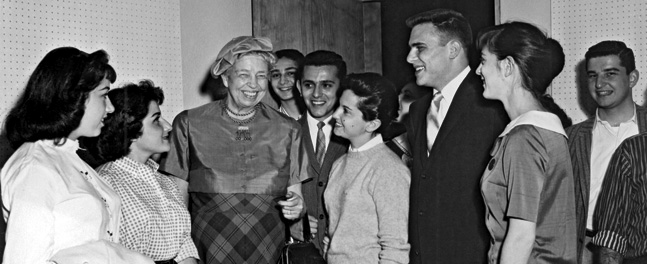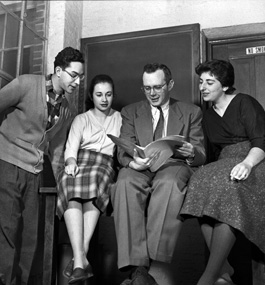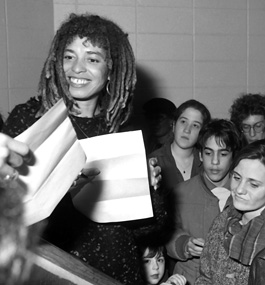Brandeis and the Soul of American Political Activism
A new book shows how, during the university’s earliest decades, the refugees, activists and public intellectuals on the faculty shaped progressive political values in the U.S.

Brandeis Archives and Special Collections
CASTING HER AURA: Founding Brandeis trustee Eleanor Roosevelt on campus in 1958.
by Alex Green ’04
Stories about Brandeis’ early years are often retold by students, faculty and alumni as if from a great distance, with reverence and awe.
This near-mythic attachment to the university’s origin story — which unfolded only 72 years ago — threads throughout “Learning on the Left: Political Profiles of Brandeis University,” slated to be published by Brandeis University Press in September. Author Stephen J. Whitfield, PhD’72, the Max Richter Professor Emeritus of American Studies, explores the university’s place in the creation of American liberalism and radicalism, mostly from the end of World War II through the early 1970s.
The work of the philosophers, writers and political activists who made up a sizable portion of the Brandeis faculty often went against the grain of mainstream political institutions and values in America. From Eleanor Roosevelt to Herbert Marcuse, the figures Whitfield profiles converge — and sometimes collide — in ways that highlight the energy and importance of this fledgling university, whose survival was by no means assured.
This is a tale with personal connections for Whitfield, who arrived on campus as a graduate student in 1969, as the era he chronicles was coming to a close, then taught at Brandeis from 1972 until his retirement in 2016. Here, in an interview that’s been edited and condensed for publication, he discusses his passion for the project, and what he learned.
What was the America that Brandeis was born into in 1948, and what was the university’s place in that America?
Brandeis has been unusual. It was singular at the very beginning. It is the only nonsectarian Jewish-sponsored private institution of higher learning in the world. It was born in the immediate aftermath of the Second World War, when there was still plenty of antisemitism in all sorts of places, including the academy.
In that particular historical moment, Brandeis wanted to ensure that American Jews could fight for the right to be equal while, at the same time, enjoying the freedom to be different. It was the effort to reconcile these two ideals that was responsible for the inauguration of the university.
There was no guarantee it would succeed.
That’s right. The university’s success began with Abram Sachar — its president for the first two decades — and a very, very committed Board of Trustees. Many of the trustees had never attended college. But they ensured Brandeis would be able to succeed financially and academically.
For instance, Jacob Goldfarb, an underwear manufacturer, gave the university enough resources to build up its library so it was significantly better than the beach reading that it had inherited. Sachar would always say, “It’s easy to get money for a building. It’s very hard to get money for a sewage system.” So Goldfarb allegedly told Sachar that if he ever got a bigger donor for the library, he’d be happy to relinquish its being named for him. That’s terrific.
Yet the library is still named for Goldfarb.
Maybe Sachar couldn’t get another donor!

Brandeis Archives and Special Collections
Irving Howe (second from right) in 1954.
page 2 of 3
Was there a unifying characteristic of the politics you describe as being at the heart of the university during those early years?
In the aftermath of the Second World War, and with the recent memory of the New Deal and the Fair Deal, liberalism was very much on a roll. Liberalism was responsible for licking the Great Depression and responsible, in all sorts of ways, for defeating the Axis Powers. But that began to change in the late 1940s and early 1950s.
Liberalism, especially Jewish liberalism, largely came to be defined by the great unsolved question of democracy and equality — the “race question.” How do you ensure the rights of African Americans? The definition of a liberal was basically somebody who championed civil rights.
Brandeis has been unusual because of the liberalism of its faculty, its students and, broadly speaking, the American Jewish community. This liberalism was at variance with what happened in the early 1950s, when the election of a Republican administration and a Republican Senate pushed back against the liberal momentum of the two previous decades. Brandeis went in a very different direction.
Yale students almost invariably were Republicans. So were Princeton students. Democrats existed at those places, but Brandeis was really different. At Brandeis, Democrats operated in many ways at the right end of the spectrum. I don’t want to exaggerate this, but Brandeis had many people who were clearly socialists and radicals of various kinds. Except for places like Brandeis, Ann Arbor, Berkeley and Madison, American campus life was conservative and politically passive, if not politically indifferent.
Eleanor Roosevelt looms large among the book’s faculty profiles. She seems to be a bridge between the university and the outer world in very powerful ways. Why do you think she stands out?
You could argue that the most famous faculty member in the history of the university was Eleanor Roosevelt.
She served initially on the Brandeis Board of Trustees. From 1959 until 1961, she served on the Brandeis faculty. She lent the university extraordinary prestige. She was a dedicated liberal carrying on the tradition of her late husband, ardently committed to racial justice and committed to the newly founded State of Israel.
Roosevelt was also an extraordinarily controversial figure because she was so dedicated to racial justice and liberal ideals. Racists and bigots hated her. At least one Ku Klux Klan chapter put a price on her head. So she lent a remarkable aura to the university in the various roles she played, which she took very seriously. She gave Brandeis a visibility it otherwise would have lacked. That visibility had a liberal, perhaps even a militantly liberal, ambience.
She hosted a public television series that was telecast from campus, in which she interviewed prominent figures in American and international politics. It was done mostly to promote the United Nations; she had been a U.S. delegate to the UN.
In the international-organization courses she taught at Brandeis from 1959-61, her co-teacher was Lawrence Fuchs, who taught American civilization and politics. Even before the 1960 presidential election, Fuchs was a supporter of Sen. John F. Kennedy. Roosevelt supported Adlai Stevenson. Fuchs was able to bring Sen. Kennedy to campus to meet with and make his case to Roosevelt. Her endorsement would mean a great deal to whoever became the Democratic nominee.
Kennedy did not succeed with Roosevelt at the beginning, at least not at Brandeis. But Fuchs’ interventions softened her hostility. By the end, when the alternative was Nixon, she came out very strongly for Kennedy. So Brandeis played a very modest but still noteworthy role in steering American liberalism away from nostalgia for Adlai Stevenson and toward Sen. Kennedy of Massachusetts.
Each of the people in your book represents a thematic place in our story as Americans. Not all were formally trained academics. Who stands out as particularly emblematic?
Irving Howe, who was born in the Bronx in 1920, had never taught before, except briefly at Sarah Lawrence. He was hired after demonstrating his command of Yiddish, even though he was assigned to teach English. He and his colleague Lewis Coser, a refugee who taught sociology, founded the magazine Dissent in 1954. It is now the longest-running democratic leftist magazine in the English-speaking world, and it started at Brandeis. When Coser began teaching, he did not have a doctorate. Howe never got a doctorate. Yet they had a considerable impact at Brandeis as teachers, writers and public intellectuals.

Brandeis Archives and Special Collections
A STRIKING CASE: Angela Davis ’65 (shown here during a 1987 visit to campus) came to hold more-leftist political views than those espoused by Marcuse, her mentor at Brandeis.
page 3 of 3
What impact did teachers like Howe and Coser have on the student body?
The intimacy between faculty and students was much more pronounced at Brandeis than at almost any other place. Michael Walzer ’56 was clearly a protégé of Howe, in particular, but also Coser. He was involved in Dissent virtually from the very beginning, as an undergraduate, then became a co-editor from his post at Princeton’s Institute for Advanced Study.
Jeremy Larner ’58 was also influenced by Howe. He’s perhaps best-known for the script he wrote for the 1972 movie “The Candidate.” It is a remarkably far-seeing film about the ways consultants and media experts shape political campaigns. Larner won the Oscar for Best Original Screenplay that year.
Angela Davis ’65 is a very striking case of somebody who moved, if anything, to the left of her mentor Herbert Marcuse, who taught politics at Brandeis from 1954-65. She is the only one of the radicals I write about who actually became a communist.
There were many others who were shaped heavily by what they learned at Brandeis without becoming as militant or liberal. For instance, Michael Sandel ’75, who teaches political philosophy at Harvard, is an important political theorist. Thomas Friedman ’75, the New York Times foreign affairs, politics and globalization columnist, is a three-time Pulitzer Prize winner.
This book came about because of your work with students.
Yes, I was working with Rachel Lebeaux ’04, an American studies major who did a readings course with me on Brandeis’ history. I realized that maybe there’s something here that needs to be told and rescued from oblivion. I justified the asymmetry of focusing in on the early years by reasoning that they will perhaps be the hardest to relate in detail in the future.
Research is one of the great joys and bedevilments of this kind of work. During your years of archival research, what was the most stunning discovery you made?
Probably the existence of a philosopher I’d never heard of. Jean van Heijenoort taught at Brandeis near the end of his life. He was a mathematical logician who, amazingly enough, had also been a bodyguard for Leon Trotsky — he wasn’t there on the day in 1940 when an assassin gained access to Trotsky’s office and murdered him. Van Heijenoort also had an affair with someone who would become the most famous female painter in history, Frida Kahlo. Writing about him was one of the great pleasures I had in doing this research.
With your knowledge of the people you write about in the book, what advice would you give new faculty members today?
Appreciate Brandeis’ past, grasp its remarkable qualities and express gratitude for what early generations built. The past is there. It cannot be relived, but it should not be lost.
Alex Green is a teacher and writer based in Waltham.
